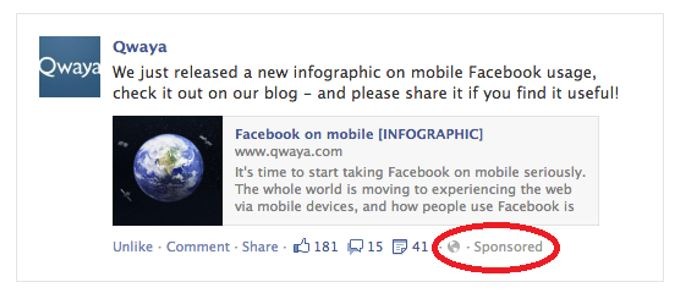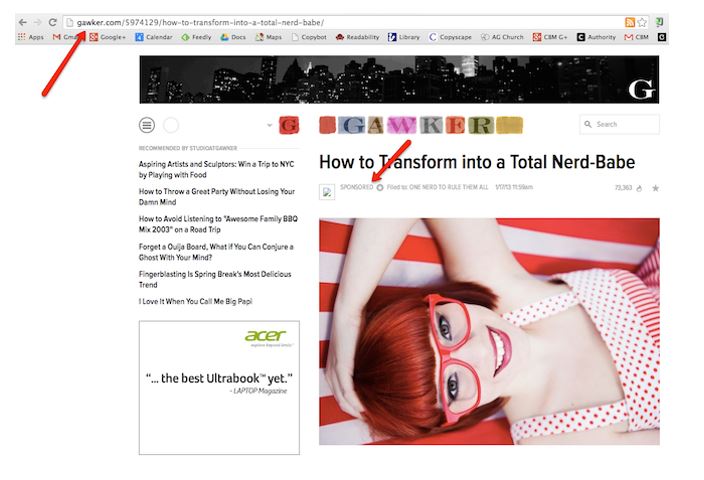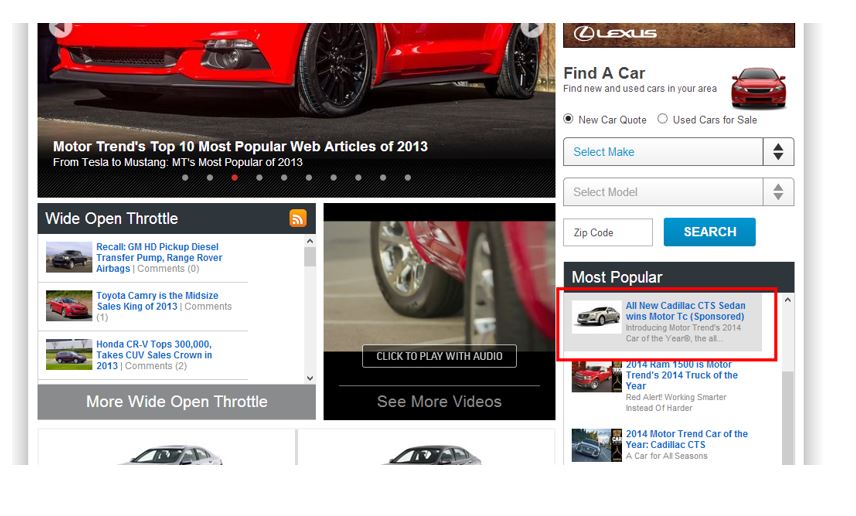Native Advertising: The Next Generation of Online Advertising or Just Smoke and Mirrors?
‘Sponsored.’
‘Promoted.’
(Ad).
These three words are polarized—signalling frustration for some, the future of online advertising for others. So what’s the deal then? Is Native Advertising a useful tool for online marketers?

What is Native Advertising?
As online advertising becomes more sophisticated, the line between editorial content and advertising is blurring. At its simplest, Native Advertising is defined as ad units that match the form and function of the publisher’s website on which they reside. Here are a few examples to help clarify:
- Promoted Tweets on a user’s Twitter feed:

- Sponsored Posts on the Facebook newsfeed:

- Sponsored Content articles or links on a website:

- Links to articles that highlight the promoted brand:

All of these examples look like they are a part of the website, but they are actually paid placements promoting a brand.
There are many different forms that fall under the Native umbrella, but ‘sponsored posts’ are cited frequently. Sponsored posts can be written by the editorial staff of a publisher that an advertiser will pay to be associated with, or they can be a piece that was written by the advertiser’s staff and submitted to the publisher for inclusion on their site. The latter often comes in the form of reviews or thought pieces that compare the advertiser’s products to their competitors.
Because the content of these ads is theoretically more useful to the reader, the click through rates (CTRs) are often hundreds of times higher than traditional display ads. That’s a big deal to nerds like us in the online marketing world!
Leveraging the loyalty of the publisher’s website is another important aspect of Native. An advertiser can piggyback on the considerable respect and established audiences that nameplates like Forbes, Mashable and Huffington Post all have. That is, if your ad passes strict standards and is relevant to the publisher’s site.
Mind Your P’s and Q’s
Native Ads differ from traditional display ads in their ability to be less intrusive or disruptive to the user experience of a website. Whereas typical display ads are very obvious, the chameleon nature of Native sees ads fully integrated into the stream of information that a user consumes. It’s not always readily apparent that a brand is being promoted and this is the part that creates controversy. When used properly and ethically, Native translates into a very powerful form of engagement, but when used deceptively, it can erode a brand’s image and alienate users.
And don’t forget about the feds! Advertising regulatory boards around the world are drafting regulations to ensure that these type of ads are clearly identified and don’t use a ‘bait and switch’ model to entice clicks.
How to Win with Native Ads
The key to effectively using Native Advertising is to ensure that the content is relevant to the publisher’s site, true to the advertiser’s brand, and is interesting enough to click on. Quality publishers know this and will often be extremely picky about which advertisers to do business with.
A crucial exercise is to put yourself in the shoes of the person that you’re targeting. Would you find the ad annoying and intrusive or would you find it interesting and relevant? Would you share it with your friends and family? If you answer can answer these questions favourably, then you’re well on your way to Native Advertising success!
In a nutshell—if you’re placing a Native Ad on a car themed blog site, you better make sure that your ad is related to cars! It’s as simple as that.
Relevancy = Sharing
Pure native advertising is created with the intention to provide compelling content that will be shared by users. That’s why we’ve seen a recent uptick of big brands creating content that is actually interesting and creative. The power of sharing means that brands can see big engagement numbers from a comparatively low budget.
Create something awesome! Not only will it educate or influence with people, but by being online the readers are able to share it with others over and over again! If the internet has taught us anything lately, it’s that content must “connect” with the consumer to go viral. Relevancy = Engagement = Success.
A Helping Hand
Native is already a multi-billion dollar industry and it’s expected to more than triple within the next two years. This makes it one of the fastest growing online ad formats out there! While I’m hesitant to suggest that Native will ever completely replace traditional display, it represents an exciting and powerful option for advertisers looking to expand their online marketing presence.
This post has given you a strong foundation of knowledge about this burgeoning industry, so when you’re surfing the web later today (let’s be honest, we all will), see if you can spot and identify some Native ads on your favourite sites. I guarantee that you’ll be surprised by how many you find!
Interested in learning more? Drop us a line, we’d love to hear from you!
